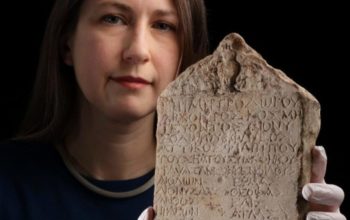Archaeologists Have Unearthed the 4,300-Year-Old Tomb of an Ancient Egyptian Dignitary-
The following written content by Francesca Aton

The tomb of an ancient Egyptian official who would have been responsible for secret documents in the royal chancellery was discovered in the ancient Egyptian necropolis Saqqara, the Polish Centre of Mediterranean Archaeology at the University of Warsaw said in a statement last week.
Expanding on an earlier excavation, the team discovered the tomb while digging within a dry moat that encircles the larger Step Pyramid of Djoser, a complex built for the late pharaoh who ruled from approximately 2630 BCE–11 BCE. There, archaeologists uncovered the tomb’s decorated entrance facade, including hieroglyphic inscriptions, rough paintings, and a relief depicting the tomb’s owner.
“The dignitary bore the name Mehtjetju and was, among other things, an official with access to royal sealed, that is secret, documents, an inspector of the royal estate and a priest of the mortuary cult of King Teti,” expedition director Kamil O. Kuraszkiewicz said in the statement. “This means that he most likely lived during the reigns of the first three rulers of the Sixth Dynasty: Teti, Userkare and Pepy I” (ca. 2300 BCE).
The reliefs would have been carved by skilled artisans, which Mehtjetju would have been able to afford given his higher social status. The rock on which it is carved, however, is brittle and eroded, but underwent treatments lead by conservators from the National Museum in Warsaw.
The decoration on the facade appears incomplete without the inclusion of polychromy. “It is possible that it was never created because the decoration of the chapel was not completed. The side walls of the entrance have no relief decoration, just figures painted in black ink on lime plaster,” Kuraszkiewicz explained. The sketches, which depict sacrificial animals such as cows, antelopes, and goats, would have functioned as a draft for later more detailed reliefs.
Researchers believe the decoration was left unfinished because of the investor’s untimely death, which resulted in a hastily completed tomb—a relatively common occurrence in ancient Egypt. Since the burial chamber has yet to be explored, it remains unclear whether Mehtjetju, his family, and/or possibly other people are interred in the tomb. The archaeologists plan to further explore the chapel’s interior this fall. Read more from Art News.





